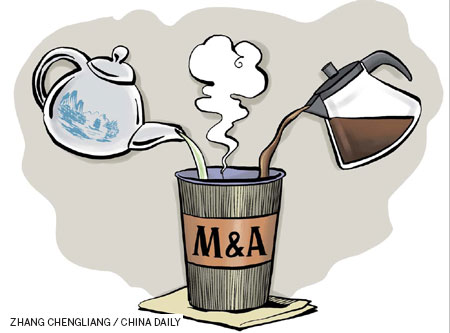Culture is potent ingredient in overseas acquisitions


Buying a company overseas can sometimes blow up in your face
Any Silicon Valley entrepreneur would no doubt instantly feel at home stepping into the workspace of my Internet startup. From the scattered laptops, bean bags, movie posters, down to the pizza boxes, the place speaks of an entrepreneurial culture that is distinctively Californian, except that our company is located just outside downtown Beijing.
The Silicon Valley entrepreneurial spirit has found a second home in the Beijing startup scene, but other US corporate cultures have had a tougher time being accepted in China. Just a few years ago I worked at a big Chinese company that was going through some painful integration after a substantial overseas acquisition.
Every quarter, the company's top brass from the US and China were put in the same room to present reviews and forecasts. The contrast was stark. The US managers gave eloquent presentations, honed and refined, I suspect, at the finest business schools and in boardrooms. The Chinese managers, in contrast, put up no-frill financial statements and pretty much read numbers off the tables. One could not help feeling that it was the US managers who had it figured out. Yet quarter after quarter, it was the Chinese who made their numbers.
Western style, PowerPoint-aided presentation feels natural to US executives, who from a tender age are encouraged to speak their minds. But it is still a concept that does not come easily to the more sternly brought up Chinese. As a small manifestation, presentation style is indicative of the many cultural differences that my old employer had to deal with, many of which brought up more serious frictions than who could create the most attractive PowerPoint charts.
These days more Chinese companies are going through what my old employer went through. Geely's acquisition of Volvo, and the recent Wanda purchase of the US theater chain AMC are a couple of the more noticeable examples of Chinese overseas ambitions. According to a PricewaterhouseCoopers report, China outward-bound mergers and acquisitions deals reached a record high of $42.9 billion (35.2 billion euros) last year.
There is good reason to be concerned about the fate of these billions. Cross-border or not, most mergers and acquisitions fail. In a Wharton article in 2005 the failure rate of mergers was estimated to be between 50 percent and 80 percent. In other words, more than half of all mergers fail, and "clashing corporate cultures" was seen as the biggest obstacle to success.
For something as complex as the integration of two companies, each involving up to tens of thousands of employees, it is impossible to pinpoint a single factor for failure. However, I believe that differences in corporate culture play a key role in the outcome.
A company's particular culture (sometimes used interchangeably with corporate DNA) runs deep. There is a saying that the company's culture is laid down by the first 10 founders and employees. After that it is nigh impossible to change. Having worked in Fortune 500 companies and building a startup from scratch, I have found much truth in this statement.
A company built on a sales-driven culture is fundamentally different to that of a cost-cutting one, which in turn is different from that of a design-driven one. Apple's success has alerted many companies to the importance of design. They have since tried to change their cultures to ones that concentrate more on fostering innovative and user-friendly design. Yet few have matched Apple's success or even come close.
To change a company's culture you have to change the incentive structure, decision-making processes, and organizational structure. It is arguably easier to just sell the company and use the money to build another one from scratch.
In the classic merger analysis, culture is often an afterthought, patched on (if at all) after the financial analysis is done. The fact is that all the synergies on paper will fail to deliver if the two systems are at loggerheads.
Culture clashes are not restricted to cross-border mergers and acquisitions, but they are arguably more pronounced, particularly when the two entities are from China and a Western country. The former is just coming of age and learning to flex its financial muscle. The latter have established management practices but are often in financial straits.
At risk of over-generalization, if one has to use one word to describe Chinese companies, one could do worse than "family-like". Employees are expected to be dedicated, obedient and to make personal sacrifices if needed, similar to junior members of a typical Chinese household.
Understandably such practice is at odds with Western management practices, which (again, as a sweeping generalization) are more process-driven, respectful of personal space and have better defined boundaries.
There is increasing interest in how these two corporate philosophies will play out as Chinese companies rise to global dominance. Japanese and Korean companies have posed similar questions before, but they have by and large learned the game of Western capitalism. China though, by dint of its sheer size, has the potential to transform the game.
At the moment though, even most Chinese executives will concede that Chinese companies are playing catch-up, and have much to learn from their Western counterparts. Given the many cash-rich Chinese companies looking to put their capital to good use, Chinese outward-bound mergers and acquisitions are likely to continue apace, but it will be a while before Chinese companies develop a management style regarded as best practice.
For Chinese companies about to make an overseas acquisition, cultural match and integration after the acquisition should be given as much thought as financial analysis.
The good news is that company cultures are increasingly more influenced by industry sectors and the challenges they face, rather than by location. A Silicon Valley startup engineer will feel more at home in a Beijing tech startup than at a large US company. A globalized market, geographic mobility of talents (many Beijing startups were founded by US educated returnees), and free flow of information are blurring national boundaries, and, one suspects, easing the complexity of cross-border mergers and acquisitions.
Another way to get around the cultural problem is not to integrate the cultures at all. When Wanda announced it was buying AMC, it said it would not tinker with AMC's operations. With the widely different tastes between the US and Chinese movie-going population, it was wise to keep the operations separate.
Indeed many acquisitions will be more successful if the mother company leaves the acquired party alone to do what it does best. Many small, research-oriented Western companies are sitting on top of patents that could be commercialized with the right owners. The advantage in such acquisitions is that the transfer of patents does not require thorough cultural integration.
One question that is not asked enough though is whether there should be a merger or acquisition in the first place. A number of overseas acquisitions by Chinese companies have been branded vanity purchases - made more for the prestige from owning a foreign company than the financial rationale behind it.
Given the fast developing domestic market, and unsuccessful record of mergers and acquisitions in general, it seems that most Chinese companies could do well by investing domestically, where the market is growing more rapidly and the rules are more familiar. In one of my MBA classes a well-known international investor was invited to speak of his experience engineering a multi-billion dollar cross-border acquisition.
"Don't try this at home," was how he started his commentary.
The author is a co-founder of demohour, China's first crowdfunding website. The views do not necessarily reflect those of China Daily.
(China Daily 07/20/2012 page9)
Today's Top News
- Xi calls for promoting volunteer spirit to serve national rejuvenation
- Xi chairs CPC meeting to review report on central discipline inspection
- Reunification will only make Taiwan better
- Outline of Xi's thought on strengthening military published
- Targeted action plan to unleash consumption momentum
- Separatist plans of Lai slammed






























